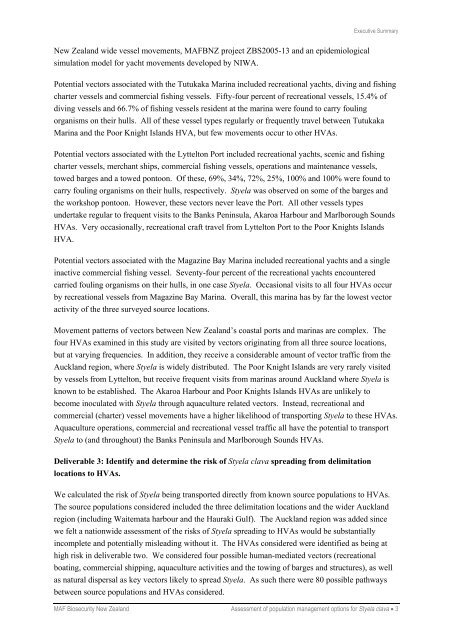Assessment of population management options for Styela clava
Assessment of population management options for Styela clava
Assessment of population management options for Styela clava
Create successful ePaper yourself
Turn your PDF publications into a flip-book with our unique Google optimized e-Paper software.
New Zealand wide vessel movements, MAFBNZ project ZBS2005-13 and an epidemiological<br />
simulation model <strong>for</strong> yacht movements developed by NIWA.<br />
Executive Summary<br />
Potential vectors associated with the Tutukaka Marina included recreational yachts, diving and fishing<br />
charter vessels and commercial fishing vessels. Fifty-four percent <strong>of</strong> recreational vessels, 15.4% <strong>of</strong><br />
diving vessels and 66.7% <strong>of</strong> fishing vessels resident at the marina were found to carry fouling<br />
organisms on their hulls. All <strong>of</strong> these vessel types regularly or frequently travel between Tutukaka<br />
Marina and the Poor Knight Islands HVA, but few movements occur to other HVAs.<br />
Potential vectors associated with the Lyttelton Port included recreational yachts, scenic and fishing<br />
charter vessels, merchant ships, commercial fishing vessels, operations and maintenance vessels,<br />
towed barges and a towed pontoon. Of these, 69%, 34%, 72%, 25%, 100% and 100% were found to<br />
carry fouling organisms on their hulls, respectively. <strong>Styela</strong> was observed on some <strong>of</strong> the barges and<br />
the workshop pontoon. However, these vectors never leave the Port. All other vessels types<br />
undertake regular to frequent visits to the Banks Peninsula, Akaroa Harbour and Marlborough Sounds<br />
HVAs. Very occasionally, recreational craft travel from Lyttelton Port to the Poor Knights Islands<br />
HVA.<br />
Potential vectors associated with the Magazine Bay Marina included recreational yachts and a single<br />
inactive commercial fishing vessel. Seventy-four percent <strong>of</strong> the recreational yachts encountered<br />
carried fouling organisms on their hulls, in one case <strong>Styela</strong>. Occasional visits to all four HVAs occur<br />
by recreational vessels from Magazine Bay Marina. Overall, this marina has by far the lowest vector<br />
activity <strong>of</strong> the three surveyed source locations.<br />
Movement patterns <strong>of</strong> vectors between New Zealand’s coastal ports and marinas are complex. The<br />
four HVAs examined in this study are visited by vectors originating from all three source locations,<br />
but at varying frequencies. In addition, they receive a considerable amount <strong>of</strong> vector traffic from the<br />
Auckland region, where <strong>Styela</strong> is widely distributed. The Poor Knight Islands are very rarely visited<br />
by vessels from Lyttelton, but receive frequent visits from marinas around Auckland where <strong>Styela</strong> is<br />
known to be established. The Akaroa Harbour and Poor Knights Islands HVAs are unlikely to<br />
become inoculated with <strong>Styela</strong> through aquaculture related vectors. Instead, recreational and<br />
commercial (charter) vessel movements have a higher likelihood <strong>of</strong> transporting <strong>Styela</strong> to these HVAs.<br />
Aquaculture operations, commercial and recreational vessel traffic all have the potential to transport<br />
<strong>Styela</strong> to (and throughout) the Banks Peninsula and Marlborough Sounds HVAs.<br />
Deliverable 3: Identify and determine the risk <strong>of</strong> <strong>Styela</strong> <strong>clava</strong> spreading from delimitation<br />
locations to HVAs.<br />
We calculated the risk <strong>of</strong> <strong>Styela</strong> being transported directly from known source <strong>population</strong>s to HVAs.<br />
The source <strong>population</strong>s considered included the three delimitation locations and the wider Auckland<br />
region (including Waitemata harbour and the Hauraki Gulf). The Auckland region was added since<br />
we felt a nationwide assessment <strong>of</strong> the risks <strong>of</strong> <strong>Styela</strong> spreading to HVAs would be substantially<br />
incomplete and potentially misleading without it. The HVAs considered were identified as being at<br />
high risk in deliverable two. We considered four possible human-mediated vectors (recreational<br />
boating, commercial shipping, aquaculture activities and the towing <strong>of</strong> barges and structures), as well<br />
as natural dispersal as key vectors likely to spread <strong>Styela</strong>. As such there were 80 possible pathways<br />
between source <strong>population</strong>s and HVAs considered.<br />
MAF Biosecurity New Zealand <strong>Assessment</strong> <strong>of</strong> <strong>population</strong> <strong>management</strong> <strong>options</strong> <strong>for</strong> <strong>Styela</strong> <strong>clava</strong> • 3
















